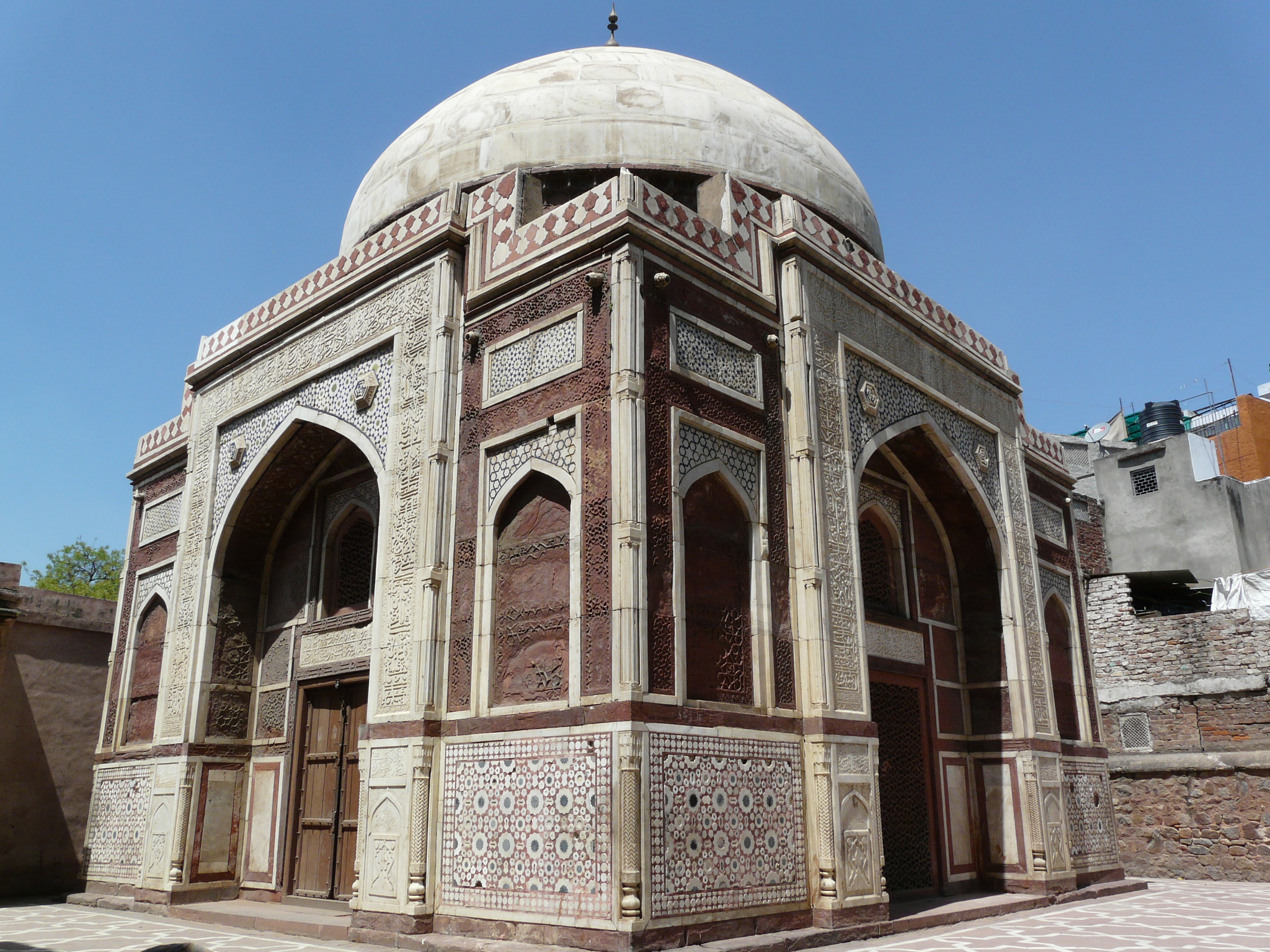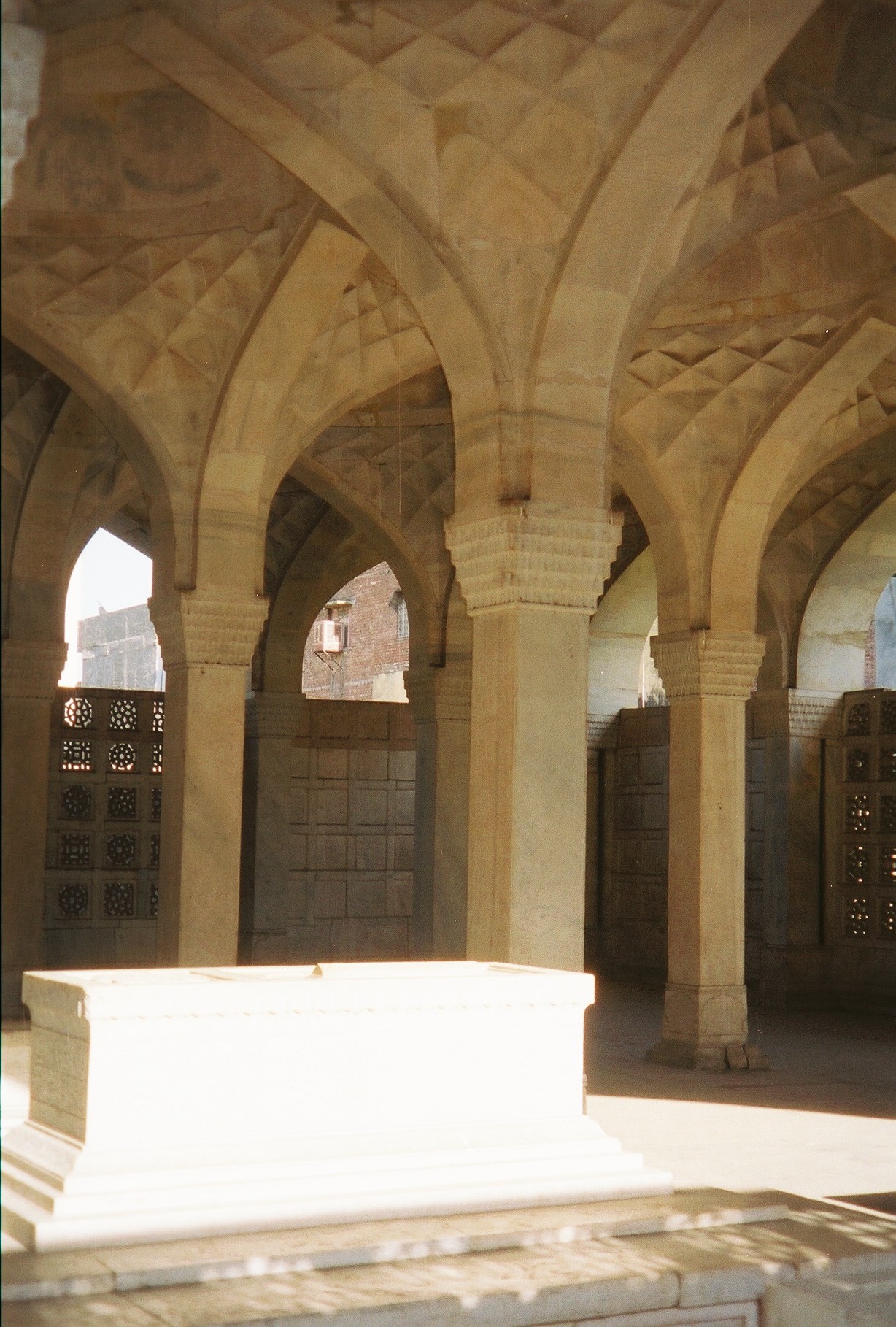Chausath Khamba on:
[Wikipedia]
[Google]
[Amazon]
Chausath Khamba, also spelled Chaunsath Khamba, is a tomb built during 1623–24. It is located in Nizamuddin precincts of Sufi Muslim shrines and tombs in
 According to inscriptions, the structure houses the tomb of Mirza Aziz Koka (also named Kotaltash). The tomb of his father,
According to inscriptions, the structure houses the tomb of Mirza Aziz Koka (also named Kotaltash). The tomb of his father,
 The Chausath Khamba is located in the busy 14th century market area of Nizamuddin Basti in New Delhi. The shrine of the Sufi saint
The Chausath Khamba is located in the busy 14th century market area of Nizamuddin Basti in New Delhi. The shrine of the Sufi saint
Chausath Khamba @Flickr
at ''
New Delhi
New Delhi (, , ''Naī Dillī'') is the capital of India and a part of the National Capital Territory of Delhi (NCT). New Delhi is the seat of all three branches of the government of India, hosting the Rashtrapati Bhavan, Parliament Ho ...
, India. The name means "64 pillars" in Urdu
Urdu (;"Urdu"
'' Hindi Hindi ( Devanāgarī: or , ), or more precisely Modern Standard Hindi (Devanagari: ), is an Indo-Aryan language spoken chiefly in the Hindi Belt region encompassing parts of northern, central, eastern, and western India. Hindi has been ...
. It was built by '' Hindi Hindi ( Devanāgarī: or , ), or more precisely Modern Standard Hindi (Devanagari: ), is an Indo-Aryan language spoken chiefly in the Hindi Belt region encompassing parts of northern, central, eastern, and western India. Hindi has been ...
Mirza Aziz Koka
Mirzā `Azīz Kokah ( fa, میرزا عزیز کوکه; ), also known as Kokaltāsh ( fa, کوکلتاش) and by his sobriquet Khān-i-A`zam ( fa, خان اعظم ''The Greatest Khan''), was the foster brother of Akbar, who remained one of the lea ...
, son of Ataga Khan
Shamsuddin Muhammad Atgah Khan (died 16 May 1562), also known as Khan-e-Kalan Shamsu'd-Din Muhammad Khan Atgah Khan, was a prominent figure in the court of the Mughal emperor Akbar.
He held important positions in Akbar's court, including that of ...
, as a mausoleum for himself, at the time when Mughal Emperor
The Mughal emperors ( fa, , Pādishāhān) were the supreme heads of state of the Mughal Empire on the Indian subcontinent, mainly corresponding to the modern countries of India, Pakistan, Afghanistan and Bangladesh. The Mughal rulers styled t ...
Jahangir ruled from Delhi. Mirza Aziz Koka had served several times as Jahangir’s Governor
A governor is an administrative leader and head of a polity or political region, ranking under the head of state and in some cases, such as governors-general, as the head of state's official representative. Depending on the type of political ...
of Gujarat
Gujarat (, ) is a state along the western coast of India. Its coastline of about is the longest in the country, most of which lies on the Kathiawar peninsula. Gujarat is the fifth-largest Indian state by area, covering some ; and the ninth ...
before he died in Gujarat.
Structure
Chausath Khamba monument was initially built as a hall in an innovative eclectic architectural style of the Mughal period. It was later converted into a tomb. It is a square structure constructed entirely of whitemarble
Marble is a metamorphic rock composed of recrystallized carbonate minerals, most commonly calcite or dolomite. Marble is typically not foliated (layered), although there are exceptions. In geology, the term ''marble'' refers to metamorphose ...
. The structure (pictured with facades) has 64 columns that support twenty five bays. Each bay supports a dome. The domes are not visible externally since they are reverse domes (picture). The roof is flat. Each wall has five arches that are held by square pilasters. In each face, between each of five pilasters, marble trellised screens
Screen or Screens may refer to:
Arts
* Screen printing (also called ''silkscreening''), a method of printing
* Big screen, a nickname associated with the motion picture industry
* Split screen (filmmaking), a film composition paradigm in which m ...
have been fixed.
 According to inscriptions, the structure houses the tomb of Mirza Aziz Koka (also named Kotaltash). The tomb of his father,
According to inscriptions, the structure houses the tomb of Mirza Aziz Koka (also named Kotaltash). The tomb of his father, Ataga Khan
Shamsuddin Muhammad Atgah Khan (died 16 May 1562), also known as Khan-e-Kalan Shamsu'd-Din Muhammad Khan Atgah Khan, was a prominent figure in the court of the Mughal emperor Akbar.
He held important positions in Akbar's court, including that of ...
, the Prime Minister of Akbar, is also in the vicinity. In addition, there are several other unidentified tombs inside this monument. It is considered the family shrine of Atgah Khan.
The structure is enclosed and has an imposing entrance gate. The Ghalib
)
, birth_date =
, birth_place = Kala Mahal, Agra, Maratha Confederacy
, death_date =
, death_place = Gali Qasim Jaan, Ballimaran, Chandni Chowk, Delhi, British India
, occupation = Poet
, language ...
tomb is located adjoining this structure on the northern side. Comparison is drawn to a similar tomb built in marble in Sarkhej in Gujarat
Gujarat (, ) is a state along the western coast of India. Its coastline of about is the longest in the country, most of which lies on the Kathiawar peninsula. Gujarat is the fifth-largest Indian state by area, covering some ; and the ninth ...
where Mirza Aziz Koka served several times as Jahangir’s Governor
A governor is an administrative leader and head of a polity or political region, ranking under the head of state and in some cases, such as governors-general, as the head of state's official representative. Depending on the type of political ...
of Gujarat. He died in Sarkhej and was temporarily buried there. His remains were later shifted to Chausath Khamba.
Heritage status
Nizamuddin Auliya
Muhammad Nizamuddin Auliya (sometimes spelled Awliya; 1238 – 3 April 1325), also known as Hazrat Nizamuddin, and Mahbub-e-Ilahi () was an Sunni Muslim scholar, Sufi saint of the Chishti Order, and is one of the most famous Sufis from the India ...
(1236 AD – 1325 AD) is nearby.
The monument is part of the Nizamuddin religious complex and has been declared a heritage building. The forecourt of Chaunsath Khamba was recently landscaped by the Aga Khan Trust. The successful Sufi qawwali music of Jashn-E-Khusrau, in which performers from India and Pakistan performed, was held here in March 2010.
Other structures
There are two other structures adjoining the Chausath Khamba, which are also heritage monuments. ;Urs Mahal Located in front of the Chausath Khamba, Urs Mahal is an assembly hall (pictured in the gallery) where Khawwali programmes are held on festival days and on the days during "Urs
Urs (from ''‘Urs'') or ''Urus'' (literal meaning wedding), is the death anniversary of a Sufi saint, usually held at the saint's dargah (shrine or tomb). In most Sufi orders such as Naqshbandiyyah, Suhrawardiyya, Chishtiyya, Qadiriyya, etc ...
of Sufi saint Nizamuddin Auliya
Muhammad Nizamuddin Auliya (sometimes spelled Awliya; 1238 – 3 April 1325), also known as Hazrat Nizamuddin, and Mahbub-e-Ilahi () was an Sunni Muslim scholar, Sufi saint of the Chishti Order, and is one of the most famous Sufis from the India ...
". It is a protected monument (refurbished in 2003).
;Mirza Ghalib’s tomb
Mirza Ghalib's tomb is a small tomb of famous Urdu poet Mirza Ghalib
)
, birth_date =
, birth_place = Kala Mahal, Agra, Maratha Confederacy
, death_date =
, death_place = Gali Qasim Jaan, Ballimaran, Chandni Chowk, Delhi, British India
, occupation = Poet
, language ...
(1797–1869), who was renowned in Urdu and Persian
Persian may refer to:
* People and things from Iran, historically called ''Persia'' in the English language
** Persians, the majority ethnic group in Iran, not to be conflated with the Iranic peoples
** Persian language, an Iranian language of the ...
poetry during the Mughal period
The Mughal Empire was an early-modern empire that controlled much of South Asia between the 16th and 19th centuries. Quote: "Although the first two Timurid emperors and many of their noblemen were recent migrants to the subcontinent, the d ...
. It is a protected monument. The tomb is a work of art located north of the enclosure of the Chausath Khamba.
References
External links
Chausath Khamba @Flickr
at ''
Columbia University
Columbia University (also known as Columbia, and officially as Columbia University in the City of New York) is a private research university in New York City. Established in 1754 as King's College on the grounds of Trinity Church in Manhatt ...
''
*
{{Authority control
Mughal architecture
Mausoleums in Delhi
1620s establishments in India
Monuments of National Importance in Delhi